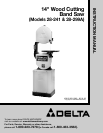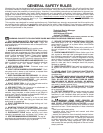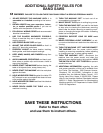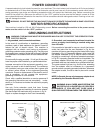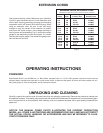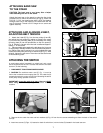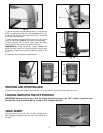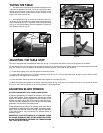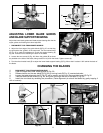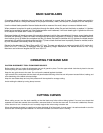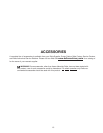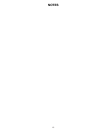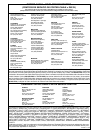
12
OPERATING THE BAND SAW
CAUTION: DISCONNECT TOOL FROM POWER SOURCE.
Before starting the tool, make all adjustments and put all guards in place. Turn the upper wheel clockwise by hand to be sure
that everything is correct prior to turning the tool on.
Keep the top guide close to the work. Do not force the material against the blade.
Light contact of the workpiece with the blade will permit easier following of the line and will prevent excess friction, heating, and
work-hardening of the blade at its back edge.
Keep the saw blade sharp and very little pressure will be required for average cutting.
Avoid twisting the blade by turning abrupt corners.
CUTTING CURVES
When cutting curves, turn the stock carefully so that the blade may follow without being twisted. If a curve is so abrupt that
repeated new kerfs are needed, then use either a narrower blade or one that has more set. The more set a blade has, the eas-
ier the stock is to turn. However, the cut is usually rougher than when using a medium set.
When withdrawing the blade, be careful not to draw the blade off of the wheels. In most cases, it is easier and safer to turn the
saw and saw out through waste material. Do not back the blade out while the saw is running.
BAND SAW BLADES
A bandsaw blade is a delicate piece of steel that is subjected to a great deal of stress. Proper blade care results in
optimal performance. Always use blades of the proper thickness, width, and temper to correspond to the workpiece.
Use the widest blade possible. Narrow blades should be reserved for small, abrupt curves and delicate work.
When pressure is required to push a workpiece through the blade, either file and set the blade, or replace it. A broken
blade can be welded or brazed, but if the blade has been work-hardened, it will soon break again. A good rule of thumb
is to sharpen the blade after 4 hours of operation.
Band saw blades will break because of the peculiar stresses to which they are subjected. However, many blades break
because the operator (1) does not check the alignment and adjust the guides; (2) forces or twists the blade around a
short-radius curve; (3) feeds the workpiece too fast; (4) allows the blade to become dull; (5) tightens the blade tension
excessively; (6) sets the top blade guide too high; (7) uses a blade that has been improperly brazed or welded; and/or
(8) runs the blade continuously when not cutting.
Blades for the standard 14" Band Saw are 93-1/2" long. The saw can adjust to a maximum length of 94" and a mini-
mum of 91-1/2". If the saw is equipped with the accessory Height Attachment, the blades should be 105" long.
Maximum and minimum lengths are 106" and 103-1/2".



